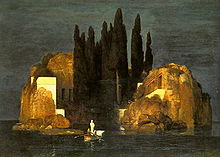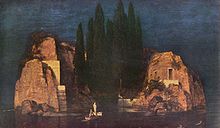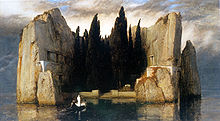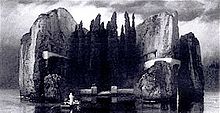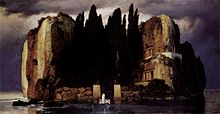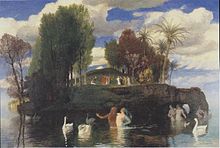- Isle of the Dead (painting)
-
Isle of the Dead (German: Die Toteninsel) is the best known painting of Swiss Symbolist artist Arnold Böcklin (1827–1901). Prints of the work were very popular in central Europe in the early 20th century — Vladimir Nabokov observed that they were to be "found in every Berlin home."[1] Freud, Lenin, and Clemenceau all had prints of it in their offices.
Böcklin produced several different versions of the mysterious painting between 1880 and 1886.
Contents
Description and meaning
All versions of Isle of the Dead depict a desolate and rocky islet seen across an expanse of dark water. A small rowboat is just arriving at a water gate and seawall on shore.[2] An oarsman maneuvers the boat from the stern. In the bow, facing the gate, is a standing figure clad entirely in white. Just behind the figure is a white, festooned object commonly interpreted as a coffin. The tiny islet is dominated by a dense grove of tall, dark cypress trees — associated by long-standing tradition with cemeteries and mourning — which is closely hemmed in by precipitous cliffs. Furthering the funerary theme are what appear to be sepulchral portals and windows penetrating the rock faces.
Böcklin himself provided no public explanation as to the meaning of the painting, though he did describe it as “a dream picture: it must produce such a stillness that one would be awed by a knock on the door.”[3][4] The title, which was conferred upon it by the art dealer Fritz Gurlitt in 1883, was not specified by Böcklin, though it does derive from a phrase in an 1880 letter he sent to the painting’s original commissioner.[5] Not knowing the history of the early versions of the painting (see below), many observers have interpreted the oarsman as representing the boatman Charon who conducted souls to the underworld in Greek mythology. The water would then be either the River Styx or the River Acheron and his white-clad passenger a recently deceased soul transiting to the afterlife.
Origins and inspiration
Isle of the Dead evokes, in part, the English Cemetery in Florence, Italy, where the first three versions were painted. The cemetery was close to Böcklin's studio and was also where his infant daughter Maria was buried. (In all, Böcklin lost 8 of his 14 children.)
The model for the rocky islet was likely Pondikonisi, a small island near Corfu which is adorned with a small chapel amid a cypress grove.[6] (Another, less likely candidate is the island of Ponza in the Tyrrhenian Sea.)
Versions
Böcklin completed the first version of the painting in May 1880 for his patron Alexander Günther, but kept it himself. In April 1880, while still working on it, Böcklin's Florence studio had been visited by Marie Berna (widow of financier Dr.Georg von Berna [1836-65] and soon-to-be wife of the German politician Waldemar, Count of Oriola [1854-1910]). She was struck by the first version of this "dream image" (now in the Kunstmuseum Basel), which sat half completed on the easel, so Böcklin painted a smaller version on wood for her (now in the Metropolitan Museum in New York City). At Berna's request, he added the coffin and female figure, in allusion to her husband's death of diphtheria years earlier. Subsequently, he added these elements to the earlier painting. He called these works Die Gräberinsel ("Tomb Island").[7] (Sometimes the "Basel" version is credited as the first one, sometimes the "New York".)
The third version was painted in 1883 for Böcklin’s dealer Fritz Gurlitt. Beginning with this version, one of the burial chambers in the rocks on the right bears Böcklin's own initials: "A.B.". (In 1933, this version was put up for sale and a noted Böcklin admirer, Adolf Hitler, acquired it. He hung it first at the Berghof in Obersalzberg and, then after 1940, in the New Reich Chancellery in Berlin. It is now at the Alte Nationalgalerie, Berlin.)
Financial imperatives resulted in a fourth version in 1884, which was ultimately acquired by the entrepreneur and art collector Baron Heinrich Thyssen and hung at his Berliner Bank subsidiary. It was burned after a bomb attack during World War II and survives only as a black-and-white photograph.
A fifth version was commissioned in 1886 by the Museum of Fine Arts, Leipzig, where it still hangs.
In 1888, Böcklin created a painting called Die Lebensinsel ("Isle of Life"). Probably intended as an antipole to the Isle of the Dead, it also shows a small island, but with all signs of joy and life. Together with the first version of the Isle of the Dead, this painting is part of the collection of the Kunstmuseum Basel.
The five versions
- May 1880 - Oil on canvas; 111 x 115 cm; Öffentliche Kunstsammlung, Kunstmuseum, Basel.
- June 1880 - Oil on board; 74 x 122 cm; The Metropolitan Museum of Art, Reisinger Fund, New York.
- 1883 - Oil on board; 80 x 150 cm; Alte Nationalgalerie, Staatliche Museen zu Berlin.
- 1884 - Oil on copper; 81 x 151 cm; destroyed in Rotterdam during World War II.
- 1886 - Oil on board; 80 x 150 cm; Museum der bildenden Künste, Leipzig.
Works inspired by Isle of the Dead
Paintings
- As is self-evident, Salvador Dalí's 1932 painting The Real Picture of the Isle of the Dead by Arnold Böcklin at the Hour of the Angelus is inspired by Böcklin's work.
- The Swiss artist H. R. Giger created a version of the picture, Hommage à Böcklin (1977), in his typical "biomechanical" style.
- Italian comicartist Gipi did an everyday-life-version of the Island of the Dead [1]
Theater
- August Strindberg's play The Ghost Sonata (1907) ends with the image of Isle of the Dead accompanied by melancholy music. It was one of Strindberg's favorite pictures.
Films
- Val Lewton's 1945 horror film Isle of the Dead was inspired by the painting which serves as a backdrop to the picture's title sequence. In an earlier film, I Walked with a Zombie (1943), Lewton had also alluded to it, placing it quite visibly on a wall in one scene. Lewton had been fascinated and terrified by a replica as a child.
- The painting is the explicit backdrop for Norman McLaren's short animated film A Little Phantasy on a 19th-century Painting (1946).
- The Quay Brothers' 2005 film The Piano Tuner of Earthquakes is said to be inspired by the painting, as well as by the book The Invention of Morel by Bioy Casares. Some of the scenery in the film (shot in a studio in Leipzig) is particularly reminiscent of the Leipzig version of the painting.
Literature
- Heinrich Mann's 1903 novel Die Göttinnen oder Die drei Romane der Herzogin von Assy (The Goddesses, or The Three Novels of the Duchess of Assy) uses the painting's imagery without explicitly mentioning it.
- In Vladimir Nabokov's Mary (1970; English translation of Mashen'ka [Машенька, 1926]) it is mentioned that a copy of The Isle of the Dead hangs in the room occupied by Klara.
- In Friedrich Dürrenmatt’s 1952 novella Der Richter und sein Henker (The Judge and His Hangman), the painting is mentioned and functions as a harbinger of doom.
- In J.G. Ballard's 1966 novel The Crystal World, Böcklin's second version of the painting is invoked to describe the gloom of the opening scene at Port Matarre.
- Roger Zelazny used the picture as an inspiration for the meeting place of two mythological antagonists in his novel Isle of the Dead (1969).
- A French graphic novel in five tomes, L'île des morts, was published on the Böcklin painting's theme with a strong influence of writer H. P. Lovecraft's Cthulhu Mythos by the editor Vents d'Ouest at Issy-les-Moulineaux, in 1996.
- The Italian illustrator Milo Manara also depict this painting in one of his graphic novels (Au revoir les étoiles) in which the main character revives classical paintings. [2]
- Bernard Cornwell's The Warlord Chronicles (1995-97) associates Dorset's Isle of Portland with the painting's isle. It is described as a place of internal exile and damnation. The causeway that almost links the real-life island to the mainland was supposed to be guarded to keep the "dead" (including the criminally insane) from crossing the Fleet and escaping back into Britain (a bit of literary conjecture in this historical fiction, not archaeological fact).
- In 1998 the Italian writer Franco Ricciardello won the Urania Award with a novel (Ai Margini del Caos, Aux frontières du chaos) whose plot revolves around a mystery involving the different versions of the painting.
- The German novelist Thomas Lehr (b. 1957) mentioned the painting as hanging in a hospital room in his Nabokov's Cat (1999).
- In 2008, the painting is used as one of the dreamlike setting for the comic novel Sognare, forse morire, Volume 118 of the Series Julia. Written by Giancarlo Berardi and Maurizio Mantero, Graphic by Laura Zuccheri.
Cover art
- The 5th version of the painting serves as cover art for German writer Lena Falkenhagen's novel Die Boroninsel (Boron Island).
- An album by Harald Blüchel was named after the painting. The third version of the painting is shown on the cover of this album.
Music
- The Island of the Dead (1890) is a symphonic poem by Romantic composer Heinrich Schülz-Beuthen evoking the painting.
- Sergei Rachmaninoff also composed a symphonic poem, Isle of the Dead, Op. 29 (1909), inspired by a black-and-white print of the painting. He said that had he seen the color original, he likely would not have written the music.
- One of the four tone poems of German composer Max Reger’s Vier Tondichtungen nach Böcklin (Op 128, 1913) is “Die Totensel” (No. 3), based on the painting. (The same year, Reger’s disciple Fritz Lubrich, Junior [1888-1971] composed Drei Romantische Tonstücke nach Böcklinschen Bildern (Three Romantic Tonstücke after Böcklin’s Pictures; Op 37), an organ work of which No. 3 is also The Dead Island.)
- The Swedish neoclassical band Arcana used an image of Isle of the Dead on the cover of their debut album Dark Age of Reason.
- An album by Harald Blüchel was named after the painting. The third version of the painting is shown on the cover of this album.
Anime
- From the anime Kuroshitsuji (黒執事, Black Butler) by Yana Toboso, Sebastian Michaelis (セバスチャン・ミカエリス ,Sebasuchan Mikaerisu) ferried the soul of Ciel Phantomhive (シエル・ファントムハイヴ ,Shieru Fantomuhaivu) to the Isle of the Dead. Sebastian hands Ciel Tanaka's diary, in which Tanaka details the former Lord Phantomhive's knowledge of his impending death. Sebastian carrying Ciel enters the isle and there Ciel calmly waits for Sebastian to take his soul.
Video/Card games
- A downloadable map for the computer game Aliens versus Predator 2 is based on the Isle of the Dead.
- The painting appears as a location in the Pocket PC graphical adventure game, Fade.
- The first version of the painting is prominently featured in D. Alexander Gregory's rendition of Titania's Song, from the collectable card game Magic: The Gathering
References
- ^ Nabokov, Vladimir (1936; English translations 1937, 1965), Despair, p 56.
- ^ That the boaters are arriving at, and not departing from, the island is an assumption. The oarsman is positioned to row away from the shore, but in some versions the ripples of the boat’s wake suggest that they are moving forward. Hubert, Locher (2004), "Arnold Böcklin: Die Toteninsel. Traumbild des 19. Jahrhunderts"; In: Kunsthistorische Arbeitsblätter [Translation: "Arnold Böcklin: The Isle of the Dead; Dream Image of the 19th Century"; In: Art History Worksheets], Zeitschrift für Studium und Hochschulkontakt; Issue 7/8, p. 71.
- ^ Culshaw, John (1949), Rachmaninov: The Man and his Music, pg 73.
- ^ To Marie Berna he wrote on 29 June 1880:"Am letzten Mittwoch ist das Bild "Die Gräberinsel“ an sie abgegangen. Sie werden sich hineinträumen können in die Welt der Schatten, bis sie den leisen lauen Hauch zu fühlen glauben, den das Meer kräuselt. Bis sie Scheu haben werden die feierliche Stille durch ein lautes Wort zu stören."
- ^ Upon completing Alexander Günther’s version, Böcklin sent him a letter saying that "... finally with the Toteninsel finished I think it will make quite the impression” (“…Endlich ist die Toteninsel soweit fertig, dass ich glaube, sie werde einigermaßen den Eindruck machen…“)
- ^ Harrison, Max (2005), Rachmaninoff, Continuum International Publishing Group, pg 159.
- ^ The artist apparently used this title for the rest his life, as indicated by a congratulatory telegram on the occasion of the Count's 70th birthday (1897) in which the artist refers to "…die glücklichen Besitzer der Gräberinsel..." ("... the lucky owner of ‘Tomb Island’...").
External links
- Toteninsel.net: an encyclopedia in progress dedicated to A.Bocklin's Isle of the Dead: copies, parodies, inspirations...
- The version of the painting at the Metropolitan Museum of Art in New York City
- The version of the painting at the Kunstmuseum Basel
- The version of the painting at the Old National Gallery in Berlin
- Island of the Dead and Florence's Swiss-owned so-called 'English' Cemetery, where Maria Anna Boecklin is buried
Categories:- Symbolist paintings
- 1880 paintings
- Paintings on the theme of death
Wikimedia Foundation. 2010.

